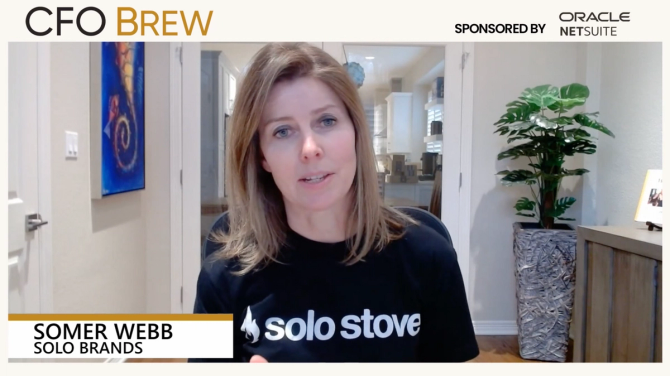Hello, and welcome to our Wednesday issue, where we are still not sure whether we are going into a recession, are already in one, or will be in one soon. Vote in our poll below; at this point, the results are as likely to be correct as all the other prognostications…
In this issue:
 C-suite collab C-suite collab
 Carbon credits Carbon credits
 Event recap: Supply-chain woes Event recap: Supply-chain woes
—Kim Lyons, Drew Adamek, Kristen Talman, Leonard Robinson
|
|
Nadezhda Buravleva/Getty Images
When San Francisco-based email authentication company Valimail began transitioning into a new strategic business model in mid-2020, the company’s chief people and performance officer, Elaine Mak, said employee engagement and talent retention were big problems.
Employees rated the company poorly on Glassdoor, and its employee net promoter scores, a measure of employee engagement, were abysmal, according to Mak. “[I said] I can’t do anything about [Glassdoor reviews] until we make some dramatic internal changes,” Mak told CFO Brew.
One of those major changes was to develop a new, more strategically aligned working relationship with Ryan McQueeney, the company’s chief financial officer, when he joined the company in October 2021.
The pair decided they needed to collaborate much more closely to successfully align the company’s talent needs and financial priorities with the larger organizational strategy.
Come together. There’s no question that engaging with and retaining talent is a top priority for finance professionals. In survey after survey, CFOs cite talent retention as one of their top concerns. Addressing those issues can’t be done by finance or HR alone, according to Amy Spurling, a former CFO and founder and CEO of Compt, an HR benefits platform.
“It has to be collaborative; it can’t just be finance deciding the number and then HR has to figure out how to split it up because you’re going to have retention issues,” she said. “That’s going to be far more costly.”
To launch their collaboration, before creating budgets and weighing head count, Mak and McQueeney wanted to understand the most effective way to work together. So they drew up a partnership agreement.
That agreement laid out, in great detail, their working styles, how each preferred to receive feedback, their ways of communicating, and how often to check in with each other. They also agreed on how to best solve the inevitable conflicts that would arise.
“It’s about meeting each other where we are at,” Mak said. Read more here.—DA
|
|
|
If you’re not in love with your expense management platform, it’s time to set your sights higher. And you won’t need Cupid’s arrow to feel a spark with Divvy.
Divvy will make this meet-cute even cuter by gifting you a $100 Amazon gift card when you complete a demo of their free, all-in-one expense management platform. Love really is in the air.
Learn how you can save time and $$$ with Divvy’s fully automated expense reports, flexible enforceable budgets, scalable business credit, and instant visibility into business spending.
Already feeling butterflies? Request a demo today and treat yourself to a sweeter spending platform.
|
|
Doidam10/Getty Images
As ESG begins to shift under the finance chief’s purview, CFOs have begun to think about how to finance that ambitious net-zero plan handed to them by the sustainability department. Entering the carbon credit market has become an appealing prospect, if you can get past the accounting barriers, experts tell CFO Brew.
Zoom out: Carbon credits, while a market was officially created under the 1997 Kyoto Protocol, gained corporate interest after the 2015 Paris Agreement was adopted. In the years that have followed, many companies have publicly issued net-zero plans, or commitments to reduce their operations to be environmentally neutral.
Carbon credits are purchasable through the cap and trade market, also referred to as emissions trading systems, which ensures environmental certainty, or if the carbon credits are really doing what the corporates purchase them for: reducing carbon. The cap-and-trade market is overseen by governments and is considered a “market-based” program, similar to that of a traditional trading market, according to the EPA.
And not to be confused—despite the word credit being in the name—carbon credits have nothing to do with tax credits, Eric Knachel, a partner at Deloitte, told CFO Brew.
The appeal: Whenever you hear the word “credit,” it’s appealing to CFOs, Frank D’Amelio, Deloitte’s CFO-in-Residence and former Pfizer CFO, told CFO Brew. CFOs are always looking for ways and opportunities to improve their results, D’Amelio remarked, and the ability to tap into a credit market could appease their stakeholders, who are increasingly demanding ESG progress. Also, the carbon markets serve as a way for companies, who had pledged to reduce their carbon footprint, to make progress.
Accounting headache: One of the biggest issues facing the carbon credit market for corporate finance is how to line-item the costs into the balance sheet, Knachel said. Continue reading here.—KT
|
|
|
Your downturn defense. Looking for ways to cut costs in an uncertain economy? Sastrify is a complete procurement platform that cuts SaaS costs, protects your runway from overspending, and saves way more than it costs. Get visibility into your entire tech stack, plus forecasting to help guide your SaaS spend. Learn more.
|
|
Did you find yourself tweaking processes a lot more than expected?
Adrianne Lee: Probably some of our bigger tweaks in the year were early on. We knew that there would be waning consumer sentiment, macro uncertainty, inflationary risks—so I think we were pretty prepared for that. We run a really lean business, so we keep our costs low knowing we would need to navigate some of these headwinds. Where we really had to pivot was the amount of promotional activity and discounting that was in the market was significant.
What parts of the company did you get to know better during the supply-chain crisis?
Somer Webb: You’re very close to sales and marketing. You want to see the calendar. You want to see inventory and where you desperately need to be forecasting inventory. But the partnership with supply chain and operations specifically was critical to that we became in lockstep. It’s not just weekly meetings, but daily updates.
You can’t sell a product that you don’t have, at least for a certain period of time. Your consumers are forgiving and they will buy it for a certain period of time. We’re not like refrigerators, however, where people will wait for two years. There is a certain amount of time that you have when you’re on consumer discretionary spending. Continue reading here.—LR
|
|
Francis Scialabba
Stat: $12 billion. That’s how much Bloomberg estimates Manhattan businesses are losing annually as workers take advantage of hybrid and remote work arrangements, declining to make stressful, trafficky commutes and opting for the comfort of their homes…where they still buy things and pay taxes, as far as we are aware? (Bloomberg)
Quote: “We need to drastically change how we do business.”—Koji Sato, incoming CEO of Toyota, explaining the need for the automaker to put more focus on electric vehicles. (the Wall Street Journal)
Read: A look at how incentives Democrats wrote into the Inflation Reduction Act are meant to bring union jobs to renewable energy projects in former coal mines or fossil fuel power plant sites. (the New York Times)
Check your spend: Many companies are overspending on SaaS—are you one of them? Sastrify’s complete procurement platform stops overspending, saving companies up to 7 figures on SaaS. Calculate your savings today.*
*This is sponsored advertising content.
|
|
There is a lot of conflicting information and varied opinions about when or if a recession might occur in the US. So we put it to you, our loyal readers, for your thoughts (and we never apologize for artful alliteration).
|
|
-
Palantir said 2023 will be the company’s first profitable year following cost-cutting measures.
-
Zoox, the robotaxi company owned by Amazon, is giving rides to employees on California roads.
-
Chevron is reportedly considering raising its mandatory retirement age of 65 for CEO Mike Wirth, who hits the milestone in 2025.
-
Ford will collaborate with Chinese company CATL on a $3.5 billion electric-battery plant in Michigan.
|
|
Catch up on top CFO Brew stories from the recent past:
|
|
|








